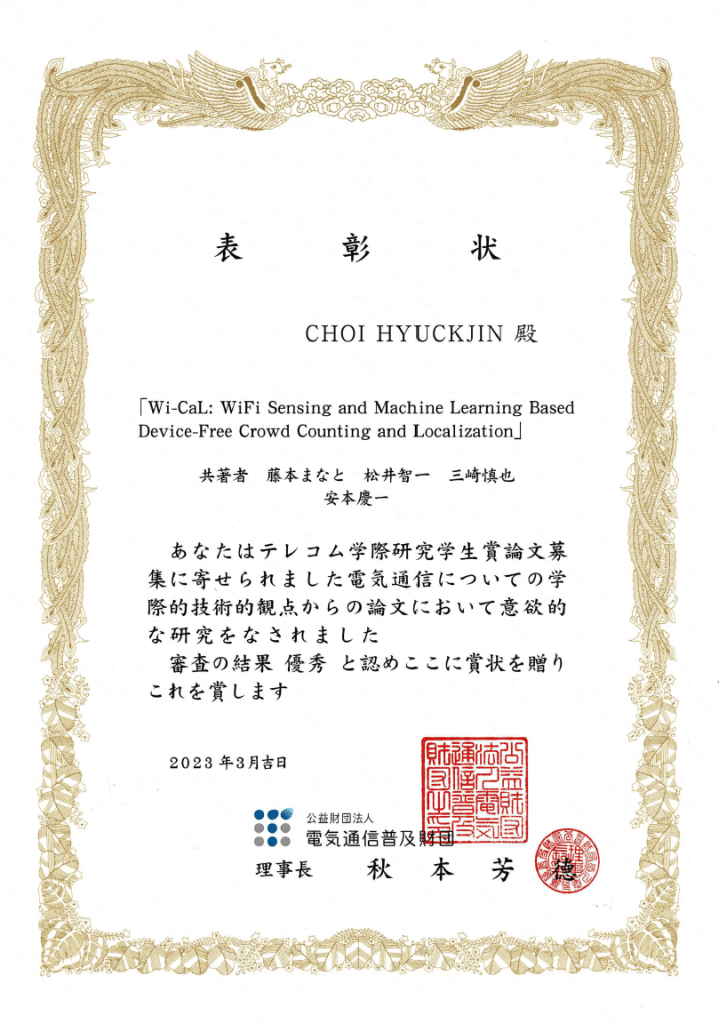第38回電気通信普及財団賞を2件受賞

電気通信普及財団が主管する2022年度電気通信普及財団賞を下記2件の論文が受賞になりました。
– 賞:第38回電気通信普及財団賞(テレコム学際研究学生賞入賞)
– 受賞者:Choi Hyuckjin
– 論文名:Wi-CaL: WiFi Sensing and Machine Learning Based Device-Free Crowd Counting and Localization
– 賞:第38回電気通信普及財団賞(テレコム学際研究学生賞奨励賞)
– 受賞者:有田 充
– 論文名:ZEL: Net-Zero-Energy Lifelogging System using Heterogeneous Energy Harvesters
Mitsuru Arita, Yugo Nakamura, Shigemi Ishida, Yutaka Arakawa
ZEL: Net-Zero-Energy Lifelogging System using Heterogeneous Energy Harvesters Proceedings Article
In: The 20th International Conference on Pervasive Computing and Communications (PerCom 2022), 2022.
@inproceedings{percom2022-arita,
title = {ZEL: Net-Zero-Energy Lifelogging System using Heterogeneous Energy Harvesters},
author = {Mitsuru Arita, Yugo Nakamura, Shigemi Ishida, Yutaka Arakawa},
url = {https://arxiv.org/abs/2202.00247},
year = {2022},
date = {2022-03-21},
urldate = {2022-03-21},
booktitle = {The 20th International Conference on Pervasive Computing and Communications (PerCom 2022)},
abstract = {We present ZEL, the first net-zero-energy lifelogging system that allows office workers to collect semi-permanent records of when, where, and what activities they perform on company premises. ZEL achieves high accuracy lifelogging by using heterogeneous energy harvesters with different characteristics. The system is based on a 192-gram nametag-shaped wearable device worn by each employee that is equipped with two comparators to enable seamless switching between system states, thereby minimizing the battery usage and enabling net-zero-energy, semi-permanent data collection. To demonstrate the effectiveness of our system, we conducted data collection experiments with 11 participants in a practical environment and found that the person-dependent (PD) model achieves an 8-place recognition accuracy level of 87.2% (weighted F-measure) and a static/dynamic activities recognition accuracy level of 93.1% (weighted F-measure). Additional testing confirmed the practical long-term operability of the system and showed it could achieve a zero-energy operation rate of 99.6% i.e., net-zero-energy operation.},
keywords = {},
pubstate = {published},
tppubtype = {inproceedings}
}
Hyuckjin Choi, Manato Fujimoto, Tomokazu Matsui, Shinya Misaki, Keiichi Yasumoto
Wi-CaL: WiFi Sensing and Machine Learning Based Device-Free Crowd Counting and Localization Journal Article
In: IEEE Access, vol. 10, pp. 24395-24410, 2022, ISSN: 2169-3536.
@article{access2022-choi,
title = {Wi-CaL: WiFi Sensing and Machine Learning Based Device-Free Crowd Counting and Localization},
author = {Hyuckjin Choi, Manato Fujimoto, Tomokazu Matsui, Shinya Misaki, Keiichi Yasumoto},
doi = {10.1109/ACCESS.2022.3155812},
issn = {2169-3536},
year = {2022},
date = {2022-03-02},
urldate = {2022-03-02},
journal = {IEEE Access},
volume = {10},
pages = {24395-24410},
abstract = {Wireless sensing represented by WiFi channel state information (CSI) is now enabling various fields of applications such as person identification, human activity recognition, occupancy detection, localization, and crowd estimation these days. So far, those fields are mostly considered as separate topics in WiFi CSI-based methods, on the contrary, some camera and vision-based crowd estimation systems intuitively estimate both crowd size and location at the same time. Our work is inspired by the idea that WiFi CSI also may be able to perform the same as the camera does. In this paper, we construct Wi-CaL, a simultaneous crowd counting and localization system by using ESP32 modules for WiFi links. We extract several features that contribute to dynamic state (moving crowd) and static state (location of the crowd) from the CSI bundles, then assess our system by both conventional machine learning (ML) and deep learning (DL). As a result of ML-based evaluation, we achieved 0.35 median absolute error (MAE) of counting and 91.4% of localization accuracy with five people in a small-sized room, and 0.41 MAE of counting and 98.1% of localization accuracy with 10 people in a medium-sized room, by leave-one-session-out cross-validation. We compared our result with percentage of non-zero elements metric (PEM), which is a state-of-the-art metric for crowd counting, and confirmed that our system shows higher performance (0.41 MAE, 81.8% of within-1-person error) than PEM (0.62 MAE, 66.5% of within-1-person error).},
keywords = {},
pubstate = {published},
tppubtype = {article}
}


